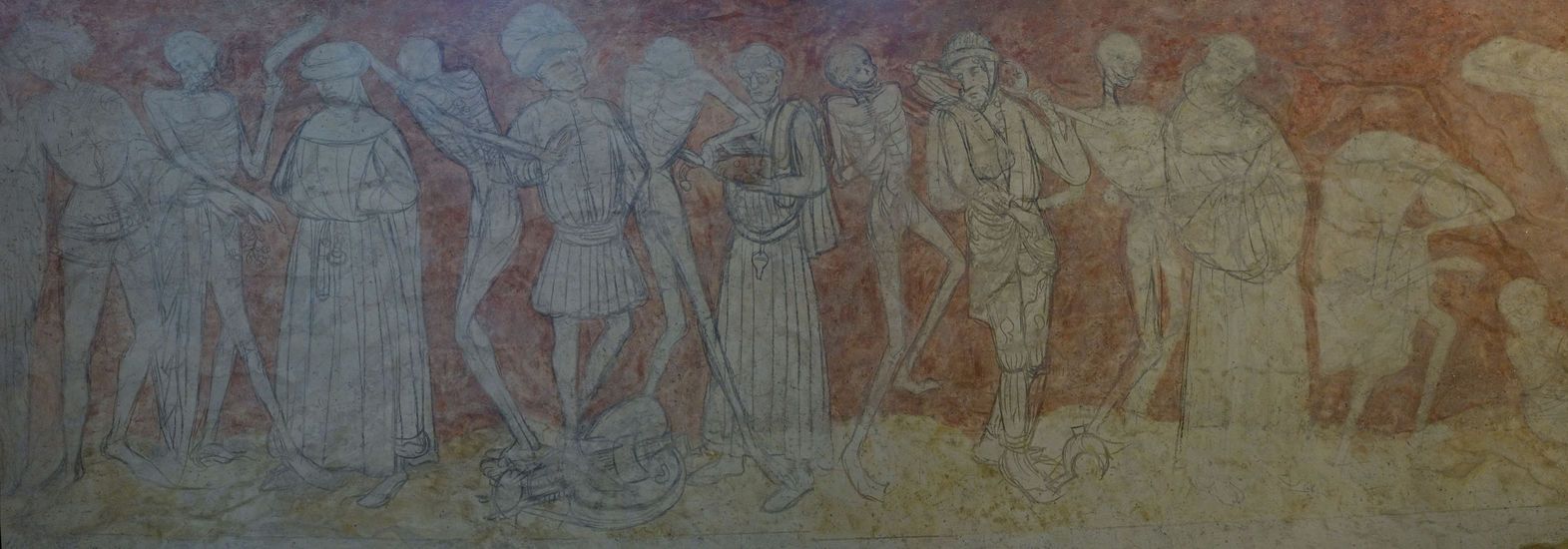La Chaise-Dieu: The Danse Macabre
(vero;2022-Nov-21)
A Danse Macabre (Dance of Death) is a painting illustrating the inexorability of death and the equality of all human beings before it. This is done by showing skeletal figures dragging the living towards their death and this whatever their station in life: mighty people, bourgeois or commoners alike.
Death was particularly present in the 15th century. Plagues and wars (the Hundred Years' War) decimated the population which in Europe was reduced by half between 1350 and 1450. The Church made the preparation for death a very important subject of reflection during this time, as witnessed by the art of this period, being poems, scenic plays in churches, paintings or sculptures.
The painting at La Chaise-Dieu spans three panels and four pillars and was painted by an unknown artist. It is difficult to date, but most of the garments are contemporary with Joan of Arc; it is therefore possible that the panels were made around 1450, which would make this mural the oldest Dance of Death found in Europe. The dead here are not really skeletons but rather cadavers with skin on their bones who dance and indulge in many facetious acts. The living (twenty-four in number), are divided into three categories: the Mighty Ones, the Bourgeoisie and the Commoners. The location of this work of art outside the choir implies that it was intended for pilgrims rather than for monks.
| Some Close-Ups with explanations | Panorama of the first panel: The Mighty Ones | Panorama of the second panel: The Bourgeoisie | Panorama of the third panel: The Commoners |
Some Close-Ups with explanations
Panorama of the first panel: The Mighty Ones
From left to right, each framed by cadavers who drag them into the dance: the Pope, an Emperor, a Cardinal, a King, an Envoy of the Pope, a Constable, an Abbot and a Knight.
| Click on the panorama to open a larger version in a separate tab. Click again to activate scrolling and use the bottom scroll bar to navigate through the picture and view it in full detail. |
 |
Panorama of the second panel: The Bourgeoisie
From left to right, each framed by cadavers who drag them into the dance: an unidentified figure, a Burgher, a Canon, a Merchant, a Nun, a Royal Sergeant, a Monk.
| Click on the panorama to open a larger version in a separate tab. Click again to activate scrolling and use the bottom scroll bar to navigate through the picture and view it in full detail. |
 |
Panorama of the third panel: The Commoners
From left to right, each framed by cadavers who drag them into the dance: a Young Man, a University Doctor, a Troubadour, a Novice, a Labourer, a Preacher, a small Child.
| Click on the panorama to open a larger version in a separate tab. Click again to activate scrolling and use the bottom scroll bar to navigate through the picture and view it in full detail. |
 |
Want to read more? Go back to La Chaise-Dieu: Details of the Choir Tapestries or go on to Other Things French or go up to Abbey of La Chaise-Dieu
$updated from: Museums.htxt Mon 04 Mar 2024 16:04:48 trvl2 (By Vero and Thomas Lauer)$












